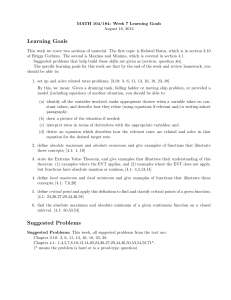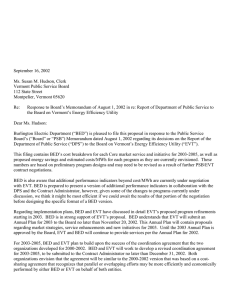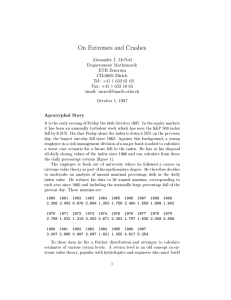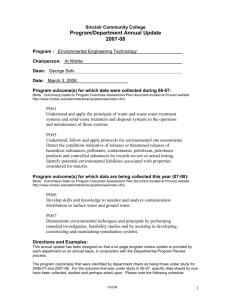Independent Audit of Vermont Energy Efficiency Utility Martin Cummings
advertisement
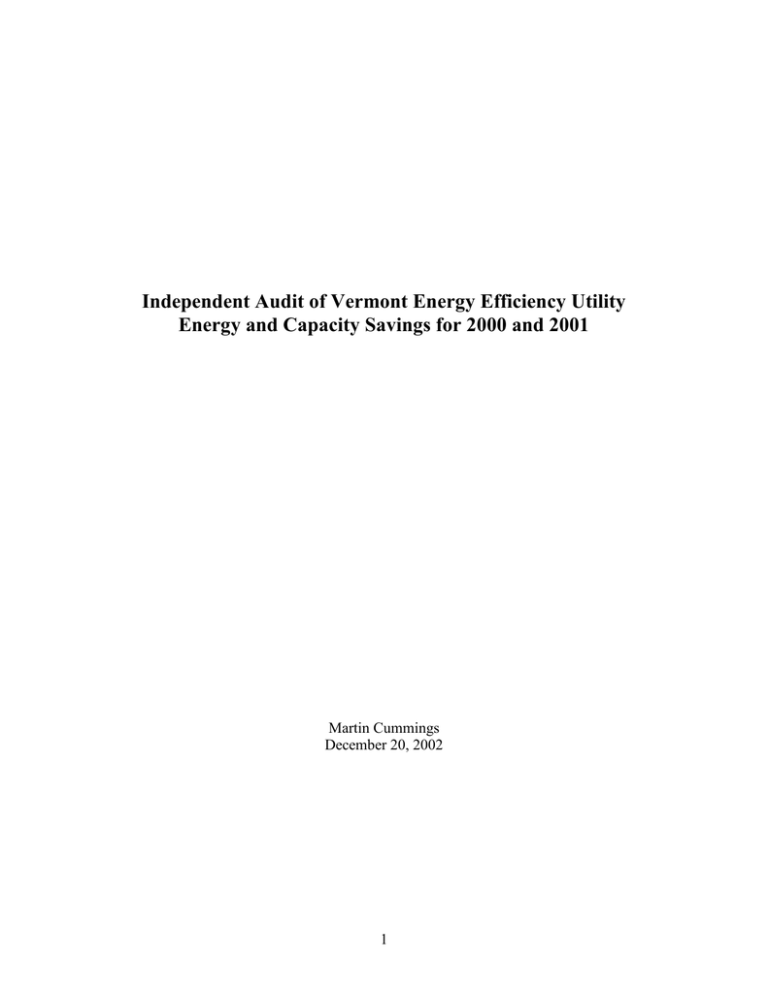
Independent Audit of Vermont Energy Efficiency Utility Energy and Capacity Savings for 2000 and 2001 Martin Cummings December 20, 2002 1 Table Of Contents Executive Summary Pg. 3 I. Introduction Pg. 6 II. Methods Used to Calculate Energy and Capacity Saving Pg. 8 III. EVT Data Collection and Analysis Procedures Pg. 12 IV. Verification of EVT Annual Report Pg. 16 V. Sources of Engineering Values and Adjustment Factors in the Technical Reference Manual Pg. 18 VI. Findings Pg. 19 Appendix – Qualifications of the Auditor Pg. 25 2 Executive Summary This audit of Efficiency Vermont (EVT) was undertaken to comply with 30 V.S.A. §209(e)(12), which requires that an independent audit of the energy and capacity savings claims and costeffectiveness of the Energy Efficiency Utility be completed by January 1, 2003. The audit focused on a review of the methods used by EVT to collect data and estimate program energy savings and the methods used by the Department of Public Service to verify EVT’s claimed savings. Because the 2002 program year was still underway at the time of the audit, the audit is limited to a review of program year 2000 and 2001 data. THE FINDINGS OF THE AUDIT ARE: The EVT estimates of Annual Energy and Capacity Savings, as verified and adjusted by the Department of Public Service, are reliable and unbiased estimates of program savings. During the period 2000 through 2001, the Efficiency Vermont Program was directly responsible for the installation of energy efficiency measures that save 59,688 megawatt-hours of electricity each year. This is approximately enough energy to meet the electrical needs of all the households in Rutland for a year. Over the 14.4-year average lifetime of these measures, they will save 861,259 megawatt-hours of electricity. Efficiency Vermont’s programs are highly cost-effective. During the period 2000 through 2001, the EVT programs were cost-effective from the perspective of both the Utility Cost Test and the Societal Cost-Benefit Test. EVT delivered energy efficiency to Vermonters at a cost of 2.68 cents per kWh. In comparison, the average price of electricity purchased by Vermont’s utilities is $0.04473 kWh. Since EVT’s per kWh cost is less than the Vermont electric utilities’ per kWh cost of generation, energy efficiency is a cost effective way to meet system needs. Using the Societal Cost-Benefit Test, the benefits of EVT’s programs (including the value of reduced environmental impacts) exceed their costs by 3.70 cents per kWh. Put another way, Vermont receives $1.93 in benefits for every dollar spent on the EVT program. For Commercial & Industrial sector programs, Vermont receives $2.14 in benefits for each dollar it spends. Most of those benefits are in the form of reduced energy costs for Vermont businesses. The cost-benefit test results are very robust. Based on the high cost-benefit ratios shown in this analysis, the EVT programs would remain cost effective even if actual savings were only 53% of estimated savings. 3 VT data collection and analysis procedures are appropriate and include effective quality assurance checks. The Department of Public Service has developed effective procedures for verifying EVT savings estimates. Table 1 summarizes EVT electric energy and capacity savings for the first two years of the program. The auditor, based upon his analysis of program cost-effectiveness, has verified these results. Table 1: Cumulative 2000-2001 EVT Verified Program Results Commercial and Industrial Sector Residential Sector Total Program Electric Energy Savings (Net at Generation) A Annualized MWh 29,745 29,943 59,688 B Lifetime MWh 469,168 392,092 861,259 C Capacity Savings (Demand Reduction) Winter Peak kW 6,403 5,274 11,677 D Summer Peak kW 3,256 2,925 6,181 Cost per kWh Saved $0.02294 $0.03068 $0.02683 F Societal Cost Benefit Test Net Societal Benefit per KWh Saved $0.04119 $0.03283 $0.03699 G Benefit to Cost Ratio 2.14 1.75 1.93 E Utility Cost Test Annualized megawatt-hour (MWh) savings (Row A) are those savings that occur in the first year the energy efficiency measures are installed. Anticipated MWh savings over the lifetime of the efficiency measures are shown in Row B. Capacity is analogous to horsepower. It is the maximum amount of electric power (kW) that can be supplied to Vermont customers at any given instant. If customer demand exceeds system capacity, brownouts or blackouts occur. Capacity savings are reductions in customer demand that improve system reliability and reduce the need for new power plants or purchase contracts. Capacity savings are particularly important during times of peak demand. Row C shows the winter peak capacity savings, and Row D shows the summer peak capacity savings. The cost per kWh of energy efficiency can be directly compared to an electric utility’s cost of generation. The Utility Cost Test (Row E) is a commonly used benefit/cost analysis tool, which estimates the annualized cost to the sponsoring utility (in this case EVT) per kilowatt-hour (kWh) of electricity saved by its programs. 4 The Societal Cost-Benefit Test (Row F) is a broader measure of program cost-effectiveness. It seeks to summarize and compare all the costs and benefits of the program, regardless of who pays the costs or receives the benefits. Costs included in the test are: EVT’s program costs (including any rebates or incentives paid to participants), performance incentives paid to EVT, participant costs, and third party costs (including DPS program evaluation costs). Program benefits included in the test are: avoided electric generation costs, avoided electric capacity costs, environmental benefits of reduced generation, and other incidental resource savings (such as reduced fossil fuel consumption, reduced water usage). The benefit to cost ratio (Row G) is calculated as the ratio of total program costs to total program benefits (see Table 5) under the Societal Cost-Benefit Test. A benefit-cost ratio of more than one indicates that a program is cost-effective. 5 I. Introduction Sections 209(d) and (e) of Title 30, as amended in 1999, gave the Public Service Board (Board or PSB) the authority to establish an Energy Efficiency Utility (EEU). The EEU was intended to improve the delivery of energy efficiency services by replacing the variety of programs offered by the State’s municipal, cooperative and investor-owned utilities with a single uniform statewide energy efficiency program. To ensure accountability, the Legislature, in 30 V.S.A. § 209(e)(12), required an independent audit of the energy and capacity savings and cost effectiveness of EEU energy efficiency programs by January 1, 2003, and every three years thereafter. In 1999 the Board awarded a contract to the Vermont Energy Investment Corporation (VEIC) to implement the EEU program under the trade name of Efficiency Vermont (EVT). The Board signed a separate contract with Michael Wickenden to serve as Contract Administrator for the program. Efficiency Vermont began to offer its energy efficiency programs in March 2000. The following year, 2001, was the first full year of program implementation. Under VEIC’s contract with the Board, Efficiency Vermont is required to submit on March 1 a report to the Department of Public Service (DPS, the Department) and the Contract Administrator describing its program accomplishments for the prior year. The DPS verifies the data and procedures used by EVT to calculate the previous year’s savings estimates, and may recommend modification of savings estimates. The Contract Administrator reviews the DPS’s recommendations and EVT’s responses to those recommendations, and makes his recommendation to the Board regarding the savings estimates. Then the Board makes a final decision regarding EVT’s savings estimates. In August EVT submits a final Annual Report that incorporates the revised savings estimates and cost-benefit test results. Table 2 summarizes reported EVT expenditures and program savings for the 2000 and 2001 program years. 6 Table 2: 2000 - 2001 EVT Program Costs and MWh Savings Program Expenditure % MWh Savings % Commercial & Industrial New Construction Market Opportunities Dairy Farms Emerging Markets $ $ $ 1,825,405 2,408,870 822,620 14% 18% 6% 9,759 16% 15,463 26% 2,246 4% $ Subtotal C&I $ 586,623 5,643,518 4% 42% 2,277 4% 29,745 50% $ $ $ $ 1,445,443 3,626,919 1,572,091 893,155 11% 27% 12% 7% 1,700 3% 21,915 37% 3,980 7% 2,083 3% $ Subtotal Residential $ 147,833 1% 7,685,441 58% Residential New Construction Efficient Products Low Income Multifamily Low Income Single Family Emerging Markets Total $ 13,328,959 265 29,943 0% 50% 59,688 The following audit was undertaken in the last quarter of 2002 by Martin Cummings under contract to the Vermont Public Service Board. Mr. Cummings has over thirty years of regulatory experience with the New York State Department of Public Service (NYDPS). He is the former Project Director for Program Evaluation for NYDPS Demand Side Management programs and has extensive experience overseeing field audits and program evaluations of electric utility energy efficiency programs. See Appendix A for additional information regarding Mr. Cummings’ qualifications. The audit focused on the procedures used by EVT to estimate program savings, and by the Department to verify those savings estimates. The objective of the audit was to determine if these procedures, as designed and implemented, yield reliable and accurate estimates of program savings and cost benefit test results. Audit conclusions are based on a field visit to EVT offices in Burlington, interviews with EVT and DPS staff and the Contract Administrator, the review of over fifty documents, and the responses to numerous E-mail and telephone information requests. Because the 2002 program year was still underway, the scope of the audit was limited to the review of the 2000 and 2001 program years. 7 EVT serves both the residential and commercial and industrial (C&I) markets and, during the time period covered by this audit, offered nine programs, including specialized programs for dairy farms and low-income customers.1 However, as shown in Table 2, nearly 80% of 2000-2001 program energy savings came from three programs. The Residential Efficient Products Program provides rebates to residential customers purchasing energy efficient lighting measures or appliances (37%); The Commercial Market Opportunities Program provides customized analyses and incentives to C&I customers replacing or upgrading equipment (26%); and, The Commercial New Construction Program provides customized energy efficiency analyses and financial incentives to C&I customers building new facilities (16%). From a measure perspective, versus a program perspective, certain types of measures accounted for a large percentage of EVT’s energy savings. While EVT offers financial incentives for a variety of energy efficient technologies, energy efficient lighting measures (both residential and C&I) accounted for over 55% of 2001 energy savings. Improvements in the efficiency of industrial processes, energy efficient motors, and energy efficient commercial and industrial refrigeration accounted for over 28% of savings. The audit accordingly focused on the key programs and efficiency measures that accounted for most of EVT’s energy savings. II. Methods Used to Calculate Energy and Capacity Savings It is helpful to think of Efficiency Vermont as providing two different levels of service to its customers. This requires two different levels of sophistication in the estimation of energy and capacity savings. At the simpler level, EVT offers residential and C&I customers rebates for standard off-the-shelf energy efficiency measures. Savings for these measures are estimated using modified engineering estimates as described in Section II.A below. EVT also offers project-specific assistance and incentives for improving the energy efficiency of unique industrial processes, and for complex commercial and industrial new construction projects. Estimating the energy and capacity savings from these projects requires complex project-specific analysis. A. Modified Engineering Estimates EVT’s energy and capacity savings estimates for standard energy efficiency measures are prepared on a measure-by-measure, program-by-program, basis using a method known as the modified engineering estimate. This is a standard method used by energy efficiency 1 Subsequent to the time period covered by this audit, the number and names of the programs offered by EVT were changed. 8 programs across the nation. Savings estimates are ordinarily calculated in two forms: gross savings and net savings. Gross savings can be thought of as the energy and capacity savings resulting from installing an energy efficiency measure that an individual customer can expect to see at the meter. Net savings are the adjusted energy and capacity savings, directly resulting from customer participation in an energy efficiency program, which a power company can expect to see at the generator. While gross savings are important to individual customers, net savings are critical for electric system planning and evaluating program cost-effectiveness. In addition, net savings benefit all of a utility’s customers since they allow a utility to purchase less power, the cost of which would have been paid for by all the utility’s ratepayers. The savings reported by EVT and verified by this audit are net savings. Sections A.1 and 2 below briefly review the concepts behind the calculation of gross and net savings from individual measures. Energy efficient compact florescent bulbs (CFLs) are used as an example. 1. Gross Savings Calculations a) Demand Reduction/Capacity Savings (kilowatt or kW) – The calculation of gross savings begins by comparing the electric demand (wattage) of the energy efficient device with the wattage of the less efficient device it will replace. For example, a 29-watt compact florescent bulb produces as much light as a 100-watt incandescent bulb, so replacing the inefficient bulb reduces the customer’s electric demand by 71 watts whenever the lighting fixture is on. From the point of view of an electric system planner, it matters a great deal when the CFLs are on since demand reductions during periods of peak usage can save system capacity, reduce costs and delay the need for constructing new power plants or negotiating new power contracts. Load shape data is used to estimate how much of the demand reduction from the CFLs will fall during on-peak and off-peak time periods. Since the lights in a house are typically turned on and off at different times than the lights in a supermarket or office or school, different load shape estimates are used for different building types. b) Energy Savings (kilowatt-hour or kWh) - Annual electric energy savings from a CFL are calculated by multiplying demand savings by an estimate of the number of hours an average bulb is turned on during the course of a year. Like load shapes, estimates of a CFL’s annual hours of use are different for different building types. Thus, a CFL which reduces demand by 71 watts would save about 244 kilowatt hours a year if installed in an office building where the lights are left on for an estimated 3,435 hours a year, but would produce different annual savings in buildings used for other purposes. 9 Lifetime electric energy savings are calculated by multiplying demand savings by the number of hours the CFLs are expected to operate before they burn out – a much longer period than the expected lifetime of an incandescent bulb. Since CFLs that are turned on and off frequently tend to fail somewhat earlier than those that operate more continually, lifetime energy savings also vary by building type.2 Compact florescent lights also have indirect effects on energy savings. Like all energy efficient measures, CFLs release less waste heat than the inefficient devices they replace. A large building lit solely by florescent lights will require significantly more energy to heat in the winter and less energy to cool in the summer than an identical building lit by incandescent bulbs. 2. Net Savings Adjustments The calculation of net savings incorporates all the factors included in the calculation of gross energy and capacity savings and adds four additional adjustments discussed below. a) Free Rider Adjustment Factor – It is likely that at least a few of the people who participate in energy efficiency programs would have installed efficiency measures even if the programs did not exist. Using our CFL example, assume a homeowner: learns about the advantages of CFLs in a magazine or from a cable TV show, makes up his mind to try out CFLs based on that information, walks into a hardware store intending to buy several CFLs, discovers at the checkout counter that he can get a rebate from EVT, and applies for and receives a rebate. That customer would be considered both a program participant (because he received a rebate) and a free rider (because the rebate had no influence on his purchase decision.) Gross energy and capacity savings estimates are adjusted downward by a free ridership factor that is determined individually for each measure in each program to account for such circumstances. b) Spillover Adjustment Factor – The spillover factor is the converse of the free ridership factor. It accounts for the likelihood that an energy efficiency program is responsible for some purchases of energy efficiency measures that never show up in the program’s tracking system. EVT’s CFL instant rebate program limits rebates to the first six CFLs purchased by a customer. Assume a customer: is motivated by EVT program literature and rebates to buy CFLs, decides to install CFLs in eight fixtures in his or her house, 2 Measure life by building type, together with (1) the difference in price between CFLs and incandescent bulbs and (2) in commercial buildings, the difference in maintenance costs that follows from the longer lifetimes of the CFLs, is used to calculate the incremental cost of CFLs in cost-benefit tests. 10 purchases eight CFLs at the hardware store, and receives rebates on six of the eight CFLs he or she purchases. The purchase of the additional two CFLs is an effect of program spillover. The purchases, and the consequent energy and capacity savings, are a direct result of the program, but the unrebated CFLs never show up on the tracking system. Another example of spillover is a customer who intends to participate in a mail-in rebate program, makes the purchase, and then loses his or her sales receipt or rebate application before he can send it in. Gross energy and capacity savings estimates are adjusted upward by a spillover factor that is determined individually for each measure in each program c) Persistence Adjustment Factor – The persistence factor adjusts for the fact that in some circumstances, anticipated savings may not persist for the normal life of the measure. For example, energy efficient lighting measures have been found to have shorter lifespans in the hostile operating environments of dairy farms. Gross energy and capacity savings estimates are adjusted downwards by a persistence factor that is determined individually for each measure in each program to account for such circumstances. d) Line Loss Factor – The application of free rider and spillover adjustment factors to gross savings estimates produces an estimate of net savings at the customer’s electric meter. However, because of transmission losses, the actual effect of the energy efficiency measures on the electric system is significantly greater. Depending on weather and system load, between 13.5% and 19.9% of the electricity generated at a Vermont power plant, or purchased from an out-of-state supplier, is lost before it reaches Vermont electric utility customers. Gross savings are adjusted upwards by a line loss factor to correct for this effect. 3. The Technical Reference Manual The formulas and values used to calculate gross and net savings using the modified engineering estimate approach are agreed upon in advance by EVT, DPS staff and the Contract Administrator, and are recorded in a lengthy and comprehensive document called the Technical Reference Manual. Section V of this report discusses the sources of the engineering values and gross-to-net adjustment factors in the Technical Reference Manual and the procedures used by EVT and DPS to update the Manual. A. Project Specific Engineering Analysis The predetermined engineering formulas and values in the Technical Reference Manual may not be adequate to estimate savings from complex commercial and industrial retrofit and new construction projects. These projects may involve: Unusual technologies (energy efficient snow making guns, for example); 11 Project-specific applications of relatively common technologies (retrofitting high efficiency motors with adjustable speed drives to an existing industrial process); or The integration of energy efficient technologies and design principles in new buildings. In these cases, energy and capacity savings estimates are based on project specific engineering analyses. These analyses are similar in principle to the modified engineering estimates used to calculate savings from rebated measures, but are more complex and utilize project-specific information provided by customers or collected on-site. III. EVT Data Collection and Analysis Procedures As noted in Section II, although EVT operated nine different programs during 2000 and 2001, over 80% of energy savings came from just three programs. The following section discusses how EVT collected and analyzed energy savings data for these major programs. EVT has adopted a formal Quality Assurance (QA) program with specific performance targets and milestones. Many aspects of the QA plan are directed towards assuring the integrity of the data and analyses that feed into estimates of energy and capacity savings. Applicable aspects of the QA program are addressed in this section. A. Residential Efficient Products Rebate Program Since the gross and net energy and capacity savings estimates per energy efficiency measure rebated have been determined in advance, the only data required to estimate total annual savings from this program is the number of valid rebates issued. The primary task is verifying that the rebates have been issued to eligible Vermont customers, and that the limit on number of rebates per customer has not been exceeded. Customers are required to enter their names, addresses, and the name of their electric utility on rebate request forms. EVT enters this information into a database where it is matched to utility account records to verify that the person receiving the rebate is eligible to participate in the program. If a rebate form cannot be computer-matched, it is matched manually. The rebate data are also analyzed to ensure that retail dealers are not violating program limits on the maximum number of instant rebates per participant. The rebate database automatically adds the savings from valid rebates to the tracking system that aggregates total program energy and capacity savings. This eliminates an unnecessary data input step, reducing the opportunity for data entry errors. EVT data input forms are designed to minimize data entry errors by rejecting inputs that fall outside acceptable limits. The company’s QA plan includes data spot checks and quarterly reports on data entry errors. 12 B. Commercial and Industrial Market Opportunities Program This program attempts to identify commercial and industrial customers at critical moments (e.g.: when they must replace failing or obsolete equipment, or when they plan to remodel or add additional equipment) and intervenes to ensure that they install the most cost-effective energy efficient equipment available for that application. The program is primarily marketed through trade allies – the contractors, engineers and equipment vendors likely to be contacted by a commercial or industrial customer when they need to replace or add to equipment. Efficiency Vermont has established working relationships with most of these trade allies and has provided training or information on efficient products. Other leads may come from “cold calls” by EVT staff, referrals from utilities, advertising in trade publications, or direct contacts by customers who have participated in the program in the past. After a lead is received, it is screened by EVT to determine if the customer’s project is a likely candidate for the installation of cost-effective energy efficiency measures. A qualifying lead is assigned to a project manager. In some cases, a trade ally may have already identified opportunities to improve the energy efficiency of the customer’s project; in other cases, EVT technical staff suggest ways to make the project more energy efficient. Some energy efficiency projects are limited to the straightforward installation of measures, such as florescent lighting fixtures with high efficiency electronic ballasts. These are covered by the predetermined engineering formulas and adjustment factors in the Technical Reference Manual. In EVT’s jargon, these are “prescriptive” projects. “Custom” projects – those that involve more complex or unusual measures or applications – require project specific engineering analyses. The initial purpose of these engineering analyses is to determine if energy efficiency improvements are costeffective. It is frequently the case that energy efficiency improvements that could save money over the long run are not installed by C&I customers because they substantially increase initial costs. To overcome this barrier, EVT may offer the customer a projectspecific financial incentive based on the engineering estimate of project savings. All energy and capacity savings estimates are based on a comparison of the energy efficient version of the project to a base case representing the project, as it would have been implemented in the absence of the EVT program. When customers have already prepared initial project plans before they are contacted by EVT, the base case is straightforward. In other cases, equipment vendors are able to provide information on the types of equipment ordinarily included in a “standard bid.” Where these sources of information are not available, the base case is usually assumed to be the minimum code standard. In most cases, the EVT project manager, or technical staff under his/her direction, prepares the engineering estimate of savings. In other cases, the trade ally who referred the customer staff prepares initial savings estimates that are subsequently reviewed and 13 approved by EVT technical staff. EVT uses industry standard engineering analysis software for thermal modeling, heating and air conditioning sizing, lighting design and some other aspects of the engineering estimate of project savings. The project managers and technical staff appear to have adequate professional training and experience to perform these analyses. Many of the project managers are electrical or mechanical engineers who are members of professional societies. Many are certified as Energy Managers by the Association of Energy Engineers. All technical staff working on commercial and industrial projects have been trained in the Vermont Commercial Construction Energy Guidelines and engineering analysis software. EVT uses data input forms for the engineering analysis software. These forms reduce data entry errors by refusing to accept inputs that fall outside of the feasible range for each item. The engineering analysis software is integrated with EVT’s tracking system to permit automatic transfer of information to the database that generates annual savings estimates. This integration reduces the opportunity for data entry errors. EVT inspects nearly all “custom” projects and all “prescriptive” projects that receive incentives greater than $2500. Once EVT has verified that the project has been completed and meets agreed standards, the energy and capacity savings estimates developed by the project-specific engineering analysis are included in that year’s estimate of program savings. The Quality Assurance plan calls for a sample of the initial project screening analyses and project-specific engineering analyses to be cross-checked and verified by a “third party” – a qualified EVT staff member who has not been directly involved in that project. A sample of completed projects is also field-inspected a second time by a “third party” EVT staff member. C. Commercial and Industrial New Construction Program This program attempts to intervene between the decision to construct a new commercial and industrial building, and the final project design. It is similar to the market opportunities program in many respects, and EVT has integrated the administration of the two programs. In addition to the energy efficient electrical equipment (lighting, motors etc.) covered by the Market Opportunities Program, the New Construction Program provides technical advice and engineering analysis for thermal envelope measures (insulation, efficient windows, etc.) and building design features (day lighting and passive solar heating, etc.). Depending on the size of the project, its potential for energy savings, and the stage the project has reached in the design process, EVT may pay for the additional architectural or engineering design work needed to improve building efficiency and/or provide incentives for the installation of specific energy efficiency measures. Although the New Construction Program, like the Market Opportunities Program, is marketed through trade allies, EVT develops many leads by monitoring the Dodge Report (a trade publication that reports on planned construction projects), other general, 14 and trade publications, and Act 250 records for project announcements. In general the base case for calculating energy savings is derived in a manner similar to the base case for the Market Opportunities program - from architectural plans developed before EVT became involved in the project, from building codes, or by determining the “standard industry practice” for constructing buildings of a particular type. Projects subject to Act 250 are treated somewhat differently.3 Act 250 requires that projects be built to higher standards of energy efficiency than non-Act 250 projects, but does not define those standards in great detail. Based on its experience administering Act 250 energy efficiency standards, the Department of Public Service has developed a baseline construction standard that represents the level of energy efficiency improvements (above industry standards) commonly required of projects approved under Act 250. EVT is allowed to claim energy and capacity savings on only those measures or design features which exceed this baseline. “Major projects” require a comprehensive plan, and they commonly receive closer scrutiny under Act 250. They are also held to a somewhat higher standard of energy efficiency. Accordingly, for major projects EVT is allowed to claim only 75% of the energy and capacity savings above the Department’s Act 250 baseline.4 D. Other Programs During 2000 and 2001, EVT offered several relatively small programs in addition to the three major programs that are the focus of this audit. The C&I Dairy Farms Program offers on site audits and energy efficiency incentives to dairy farmers. The C&I Emerging Markets Program is a C&I program which offers services and incentives to specialized markets (schools, waste water plants, etc.) and supports several small research, training and market transformation programs. The Residential Low Income Single Family and Multifamily Programs provide energy efficiency audits and incentives to low-income Vermonters. The Residential Emerging Markets Program is a Residential program that supports several small projects including the distribution of energy efficiency software to homeowners and direct telemarketing to customers with high electric bills. Claimed savings from this program have been minimal to date. Savings estimates for these programs are prepared in a similar fashion to savings estimates for the C&I Market Opportunities and New Construction Programs and the Residential Efficient Products Program. They raise no significant new measurement issues. 3 Some Market Opportunities Program projects, although not involving the construction of a new building, are subject to Act 250. Baselines for these projects are adjusted as described here. 4 These standards were in force for the 2000 and 2001 program years covered by this audit, but have been modified for subsequent program years. 15 E. Preparation of Annual Report The EVT program year ends on December 31. During the first two months of the following year, EVT: (1) completes the entry of data from rebated measures installed during the prior year, and the calculation of savings and data entry from custom measures and new construction projects completed during the prior year, (2) calculates aggregate program savings, and (3) prepares an annual report for submission to the Department of Public Service by March 1st. IV. Verification of EVT Annual Report Although EVT does not submit its formal annual report until March 1st of each year, the DPS begins its verification activities in February with a review of preliminary EVT data. From then until the beginning of May, the Department of Public Service reviews and verifies EVT’s claimed savings for the prior year. The following description of the verification process uses examples from the spring 2002 verification of EVT’s 2001 program year savings. The 2000 program year verification was generally similar. A. Department of Public Service Verification Activities In 2002, the DPS committed four staff members to the verification process over a twomonth period. DPS staff were assisted by two consulting firms – West Hill Energy and Computing (West Hill) and Science Applications International Corporation (SAIC). The Department’s verification process included the following steps. 1. Review of EVT Database – West Hill reviewed the EVT database files that generate savings estimates for rebated measures to ensure that the formulas, engineering values and gross-to-net adjustment factors were consistent with the Technical Review Manual. 2. Identification of Savings Estimate Issues Affecting Residential Projects – Based on the database review, West Hill identified a number of measurement issues which could affect EVT’s estimates of savings from residential sector programs. 3. Identification of a Sample of C&I Projects for Review – West Hill also developed spreadsheets that contained detailed measure and project data for each program. Based on this information, West Hill identified 130 projects for detailed review. The selected projects included the 25 largest projects overall, a few large projects from each program (if not included in the first group) and projects which featured unusual energy efficiency measures. Overall, the projects selected for review represented approximately 12% of EVT’s total 2001 claimed energy savings. 4. Detailed Project Review – Department staff and West Hill then interviewed EVT staff and reviewed EVT files on each selected project. The DPS and West Hill also reviewed customer billing records for selected projects. In cases where technical 16 issues arose, particularly concerning the calculation of energy savings from unusual measures, DPS staff sought advice from SAIC, an engineering firm under contract to the Department for this purpose. 5. Issue Resolution – In early April, the DPS provided EVT with an extensive list of issues to be resolved. Many of the issues concerned the calculation of EVT savings for specific large C&I projects, or the calculation of savings for complicated or unusual energy efficiency measures in the commercial and industrial sector; others concerned savings from residential programs. In most cases the DPS proposed specific reductions in energy and capacity savings for the projects or measures under review. Over the following month the Department conducted further analysis and met with EVT staff and the Contract Administrator in an attempt to resolve verification issues. In some cases, EVT agreed that the Department’s concerns were valid and voluntarily accepted reductions in claimed energy and capacity savings. In other cases EVT was able to satisfy DPS concerns. B. DPS Report to the Contract Administrator As required by the PSB, the Department reported to the Contract Administrator in early May 2002 on its analysis of EVT’s 2001 savings claims. The report described the steps the DPS took to verify savings, the issues raised during the verification process, and the Department’s proposed adjustments to EVT’s claimed savings. In 2002, DPS staff recommended that EVT’s 2001 Energy Savings estimates be reduced by 2%. The Department and EVT reached agreement on sixteen adjustments proposed by DPS, but disagreed on a DPS recommendation to reduce savings from a major ski area snowmaking project. C. Role of the Contract Administrator in the Verification Process The contract between the PSB and EVT provides that the Contract Administrator shall resolve any remaining disputes between the Department and EVT at the conclusion of the Department’s verification process, and shall make recommendations to the Board. After meeting with both parties and reviewing a response submitted by EVT, the Contract Administrator supported the Department’s position on the unresolved snowmaking issue. At the end of May, the Contract Administrator reported to the PSB, which approved EVT’s savings estimates with the adjustments recommended by the Contract Administrator. D. Final Efficiency Vermont Annual Report On August 30, 2002, EVT issued a revised annual report which included the savings adjustments recommended by the Department and approved by the Contract Administrator, and estimates of program cost effectiveness. 17 V. Source of Engineering Values and Adjustment Factors in the Technical Reference Manual The accuracy of the EVT savings estimates is, in the end, dependent on the validity of the hundreds of engineering values and adjustment factors contained in the Technical Reference Manual (TRM). It is therefore important to review the original source of this information and the procedures used by EVT, the DPS, and the Contract Administrator to update and refine it. A. Initial Source of Technical Reference Manual Data Most of the engineering values and adjustment factors in the initial (2000) version of the Technical Reference Manual (TRM), were derived from “The Power to Save: A Plan to Transform Vermont’s Energy-Efficiency Markets”, a feasibility study for the statewide energy efficiency utility. This report, issued by the Vermont Department of Public Service in May of 1997, included analyses of the potential energy and capacity savings from a variety of energy efficiency programs and technologies. The data and assumptions underlying these analyses, including engineering values and adjustment factors, are contained in appendix 3 of “The Power to Save” and associated work papers. Optimal Energy, the consulting firm that prepared this section of the report, specializes in energy efficiency programs and has conducted similar studies in several states in the Northeast. The engineering values and adjustment factors underlying its analysis were primarily derived from manufacturer specifications and from studies conducted by Vermont utilities and energy efficiency programs in other states. Annotations and footnotes in the TRM cite the sources for many, but not all, of the engineering values and adjustment factors. B. Updating the Technical Reference Manual The Technical Reference Manual has been frequently updated to add data on measures not covered in “The Power to Save” and to revise existing data as programs change or new data becomes available. The Department maintains a master copy of the TRM that records all changes in formulas, engineering values, and adjustment factors. The reasons for many, but not all, of these changes are briefly noted in the TRM. Either EVT or DPS staff may initiate proposed revisions to the TRM. The Technical Advisory Group (TAG), comprised of staff from both EVT and DPS, reviews all proposed changes. The Contract Administrator, who has the final say when EVT and DPS staff disagree, chairs the TAG. There is no single source that documents the reasons for all of the TAG’s decisions to modify the TRM. For example, there is extensive documentation supporting a TAG decision to modify the free rider rates on residential CFLs. In this case, the revised adjustment factor was based on an analysis, conducted by experienced outside program evaluators, of seven impact evaluations conducted in other states with similar CFL 18 programs. Other major changes initiated by the Department are documented in the DPS’s May 2001 and 2002 verification reports to the Contract Administrator and are supported by engineering studies performed by SAIC for that purpose. On the other hand, some minor changes are based on DPS’s and EVT’s professional judgment and are not extensively documented. C. Program Evaluations As noted in Sections V.A and B above, many of the engineering values (hours of use, load shapes, etc.) and adjustment factors (free ridership, spillover, etc.) in the TRM are based on impact evaluations undertaken by utilities or government agencies in other states. While methodologies vary, it is typical for such impact evaluations to be based on mail or telephone surveys of a statistically valid sample of participants and nonparticipants, statistical analysis of participant and non-participant bills or end use metering. Because climate, program design and market characteristics vary from state to state, extrapolation of impact evaluation data collected outside of Vermont requires careful analysis and professional judgment. The Department of Public Service has undertaken Vermont-specific program evaluation studies. However, in 2000 and 2001 these studies were limited to market characterization studies, which were intended primarily for the purpose of program planning and did not directly result in modification of the TRM. In 2002 the Department began several Vermont-specific impact evaluation studies. These studies will affect the TRM in the future, but have had no effect on savings estimates for the 2000 and 2001 program years. VI. Findings A. The Use of Modified Engineering Estimates is an Appropriate Method for Calculating Program Energy and Capacity Savings The use of modified engineering estimates to calculate gross and net program energy and capacity savings is a standard technique commonly used by energy efficiency programs nationwide.5 The basic formulas and adjustment factors (free riders, spillover) used by EVT in the Technical Reference Manual are consistent with industry practice. B. Efficiency Vermont’s Data Collection and Analysis Procedures are Appropriate and Include Adequate Quality Assurance Checks Based on the auditor’s review of EVT documents and interviews with EVT staff, the EVT staff who collect and analyze energy efficiency data have appropriate training and experience. EVT data input forms, engineering analysis programs, and tracking systems are designed and integrated to minimize data entry errors. EVT has also developed and 5 Statistical analysis of participant and non-participant bills is occasionally used to estimate program energy savings. However, such studies are expensive and can only be used successfully in special cases (for example, programs that involve weatherization of a large number of electric or gas heated single family residences). None of EVT’s programs appear to be suitable for statistical billing analysis. 19 implemented a quality assurance program, much of which is directed towards ensuring the accuracy of engineering estimates of savings. C. Department of Public Service Staff and the Contract Administrator Have Developed Appropriate Procedures for Verifying EVT Savings Estimates and Have Implemented These Procedures Diligently. Over the first two years of the EVT program, the DPS has developed detailed and effective procedures for verifying and, if necessary, adjusting EVT’s savings estimates and has obtained the specialized consulting services necessary to assist it in the implementation of the verification process. The Contract Administrator has been effective in managing the verification process and resolving disputes between EVT and the DPS. D. Although the Source of the Engineering Values and Adjustment Factors in the TRM Is Not Completely Documented, the Values That Are Documented Appear to be Reliable and Unbiased The sources of many, but not all, of the hundreds of engineering values and adjustment factors in the TRM are documented by annotations or footnotes in the TRM. Those that are documented appear to have been derived from appropriate sources. The contractor that developed the original values for “The Power to Save” had considerable experience in the field of energy efficiency and there is no reason to believe that the undocumented values are inaccurate or come from inappropriate sources. It is likely that EVT or the Department, in the course of preparing and verifying savings estimates, would have picked up any significant errors in major measures. Similarly, the reasons for major modifications of the TRM by the Technical Advisory Group are well documented, but the rationale for other modifications cannot be easily determined. It is noteworthy that many of the gross to net adjustment factors (free ridership, spillover, persistence) used to calculate program savings for 2000 and 2001 were based on program impact evaluations conducted in other states. While it would have been theoretically preferable to base these factors on program impact evaluations of EVT programs, there were practical and fiscal reasons why Vermont-specific studies were not undertaken during 2000 and 2001. Because 2000 was the first year of the Efficiency Vermont Program, and because programs did not begin until partway through the year, it would have been difficult to conduct elaborate impact evaluations in 2000, and the results of any such evaluations might have had limited validity in future years. Instead, the Department focused limited evaluation funds on baseline studies of the energy efficiency market in Vermont. The Department continued these baseline studies in 2001 and began a limited program of impact evaluations in 2002. It is important to realize that Vermont is at a disadvantage, compared to larger states, when conducting program impact evaluation studies. Although impact evaluation 20 methodologies vary depending on the program and the particular issue to be researched, it is usual for impact evaluation studies to be based on mail or telephone surveys of a statistically valid sample of program participants and non-participants. Due to the nature of sampling statistics, a major Vermont program, like the residential CFL rebate program, would probably require as large a survey sample, and cost as much to evaluate, as a much larger program conducted in New York or California. Program evaluation costs per participant are, therefore, likely to be significantly higher in Vermont than in other states. Consequently, it will probably be necessary for Vermont to limit its program evaluation work to the most critical issues and to remain dependent on out-of-state studies for less critical data. E. The EVT Estimates of Annual Energy and Capacity Savings, as Verified and Adjusted by the Department of Public Service, are Reliable and Unbiased Estimates of Program Savings. Because the calculation of program savings from the EVT energy efficiency program is necessarily dependent on a large number of engineering values and adjustment factors, some of which cannot be known with certainty, savings estimates must be recognized as just that – estimates. The audit has shown that EVT and the Department have put into place appropriate procedures and controls to minimize sources of error and bias in the estimation process. Accordingly, the savings estimates in the adjusted EVT annual reports should be considered reliable and unbiased estimates of actual program savings. The auditor verifies the following estimate of program savings for the first two years of the EVT energy efficiency program. Table 3: Cumulative 2000-2001 Electric Energy and Capacity Savings Electric Energy Savings (Net at Generation) Annualized MWh Commercial and Industrial Sector Residential Sector Total Program 29,745 29,943 59,688 469,168 392,092 861,259 Winter Peak kW 6,403 5,274 11,677 Summer Peak kW 3,256 2,925 6,181 Lifetime MWh Capacity Savings 21 F. During the Period 2000 Through 2001, the EVT Program was Cost-Effective From the Perspective of the Utility Cost Test. Using these savings estimates and EVT program expenditure data, the auditor calculated Utility Cost Test results for the 2000 – 2001 EVT program. The Utility Cost Test is a commonly used benefit/cost analysis tool, which estimates the annualized cost to the sponsoring utility6 per kWh of electricity saved by its programs. The inputs to the test are the annualized MWh savings from EVT programs, EVT’s actual program expenditures, and the average lifetime of the energy efficiency measures installed. Table 4 shows Utility Cost Test results for EVT’s program as a whole, and separately for the Commercial and Industrial and Residential market segments. Table 4: 2000-2001 Utility Cost Test Results Commercial and Industrial Sector Annualized Cost per kWh Saved $0.02294 Residential Sector $0.03068 Total Program $0.02683 It is instructive to compare the costs of electricity saved through energy efficiency to the current cost of electricity in Vermont. The average retail electric rate in Vermont is $0.10639 kWh. The average cost of the electricity purchased by Vermont utilities is $0.04473 kWh. Vermont utilities have an average transmission and distribution cost of $0.01186, which, when added to the purchase price of power, brings the cost of a kWh of electricity to the utility to $0.05659,7 about twice the cost of energy efficiency. G. During the period 2000 through 2001, the EVT Program was Cost-Effective From the Perspective of the Societal Cost-Benefit Test. The Societal Cost-Benefit Test is a broader measure of program cost-effectiveness. It seeks to summarize and compare all the costs and benefits of the program, regardless of who pays the costs or receives the benefits. The following costs are included in the test: EVT’s Program Costs – including any rebates or incentives paid to participants and performance incentives paid to EVT; Participant and Third Party Costs – mainly the measure costs above EVT rebates which were paid by participants, net of any costs paid by free riders;8 and, In this case the “sponsoring utility” is Efficiency Vermont – the EEU or Energy Efficiency Utility. Cost data supplied by Sean Foley, Department of Public Service. 8 Free riders are participants who receive an EVT rebate etc. for an efficiency measure, but who would have installed the measure even if there had been no program. Since free riders were not actually influenced by the program, both their kWh savings, and their measure costs, are netted out of program benefits and costs. 6 7 22 Administrative Costs – including DPS’s verification costs and the cost of the Contract Administrator. The following program benefits are included in the test: Resource Benefits – The great majority of the resource benefits from EVT programs come from electric energy and capacity savings. Resource benefits also include the net effects on oil and other fossil fuel consumption of improving building insulation and of switching customers from electric space and water heating to other fuels. Decreases in water consumption from energy efficient washing machines, etc. are also included in resource benefits. Environmental Benefits of Reduced Generation Table 5 shows Societal Cost-Benefit Test results for EVT’s program as a whole, and separately for the Commercial and Industrial and Residential market segments. Table 5: 2000-2001 Societal Cost-Benefit Test Inputs and Results All Programs C&I Sector Residential Sector 59,688,000 29,745,000 29,943,000 EVT Costs 9 Participant and Third Party Costs Administrative Costs10 Total Costs (adjusted for risk) $14,308,990 8,807,980 661,555 $21,400,672 $6,083,964 4,251,798 396,933 $9,659,426 $8,225,025 4,556,182 264,568 $11,741,246 Resource Benefits (Lifetime)11 Environmental Benefits ($0.007 kWh)12 Total Benefits $40,886,417 417,816 $41,304,233 $20,494,766 208,072 $20,702,838 $20,391,651 209,744 $20,601,395 $0.03699 $0.04119 $0.03283 1.93 2.14 1.75 KWh Savings Societal Benefit $/kWh Benefit/Cost Ratio Test results are shown in two formats. However, any expense (rebates etc.) incurred by EVT in serving these participants is included in EVT program costs. 9 Includes EVT performance incentives. 10 Includes DPS and Contract Administrator costs. 11 Includes electric energy and capacity savings and net change in the consumption of water and fossil fuels. 12 Based on a settlement between Vermont Utilities, the DPS and some other parties in Docket 5980. 23 Societal benefits $/kWh expresses the test results as net social benefits per kWh of electricity conserved as a result of EVT programs. The societal benefit/cost ratio compares the costs of the program to Vermonters to the benefits they receive. Overall, Vermont receives $1.93 in benefits for every dollar spent on the EVT program. The cost effectiveness of Commercial & Industrial sector programs is particularly high. Vermont receives $2.14 in benefits for each dollar it spends on C&I energy efficiency programs Most of those benefits are in the form of reduced energy costs for Vermont businesses. This test does not attempt to compute the increased employment or economic activity that results from reducing the energy costs of Vermont businesses. These are very robust cost-benefit test results. Finding E noted that program savings are based on engineering estimates that, no matter how carefully applied, may differ slightly from actual savings. Based on the high cost-benefit ratios shown in this analysis, the EVT programs would be cost effective even if actual savings were only 53% of estimated savings. Clearly, the EVT engineering estimates are far more accurate than that. There can be no doubt that, even allowing for a reasonable level of uncertainty, the Efficiency Vermont program is highly cost effective. 24 Appendix - Qualifications of the Auditor Martin Cummings ____________________________________________________________ RR#1 Box 28, North Bennington, VT 05257 (802) 442-9306 mejcummings@alum.rpi.edu 1971 to 2001 New York State Department of Public Service Environmental Analyst Energy Efficiency Analyst Project Director, Program Evaluation Program Evaluation Led staff teams in management audits of residential weatherization programs Developed energy conservation incentive mechanisms for New York State utilities Developed NYSDPS energy conservation program evaluation policies and standards Established NYSDPS’s first program evaluation unit, served as staff program evaluation expert, trained and supervised other evaluation staff Established and led a stakeholder working group which set the program evaluation research agenda for New York State electric and gas utilities Evaluated early retail access pilot program Former member of Board of Directors of the American Society of Demand Side Management Professionals Former member of Editorial Board of “Evaluation Exchange”, a national professional newsletter. Management Supervised seven professional staff in the administration of a multimillion dollar energy conservation incentive program Project Manager for multidisciplinary teams analyzing the environmental impacts of proposed power plants Environmental Analysis Analyzed land use, socioeconomic and other environmental impacts of proposed power plants and natural gas distribution pipelines Analyzed environmental impacts of regulatory policies to promote competition Analyzed environmental impacts of the sale of electric utility property and facilities 25 Communication Skills Wrote grant proposal and RFP, selected and managed contractor, helped plan a threeday stakeholder workshop on power plant siting criteria, and co-authored report Facilitated stakeholder workshops to: Define the scope of environmental impact analyses of the sale of four nuclear power plants Negotiate the resolution of environmental issues in a power plant siting case Set the research agenda of a utility program evaluation group Presented papers on program evaluation and incentive rate making or appeared as invited speaker or panelist at numerous professional conferences Presented and defended expert testimony on the environmental impacts of proposed power plants in administrative hearings Prepared numerous reports on technical and policy issues related to the electric utility industry Education State University of New York at Albany Graduate Certificate Program Regulatory Economics (4.0 average) Rennselaer Polytechnic Institute M.S. Urban and Environmental Studies (4.0 average) Princeton University A.B. American History (graduated in three years) 26
